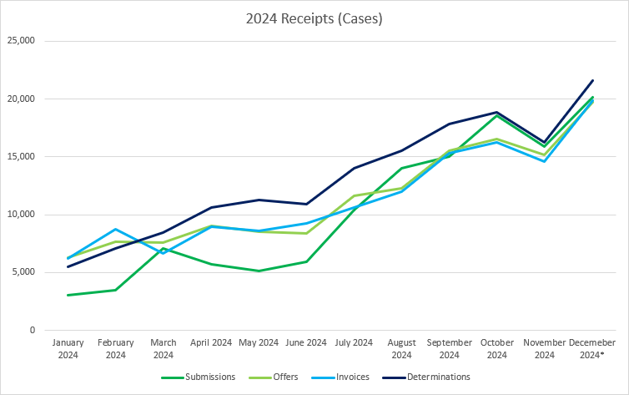January 1, 2025 marked 3 years since the No Surprises Act (NSA) went into effect. According to polls conducted by the American Heart Association, the No Surprises Act is supported by 88% of U.S. adults who view it as an important step towards protecting people’s financial well-being. While there is support for the law, articles written at the launch of the No Surprises Act often mentioned compliance concerns, with words like “daunting” and “challenging” frequently being used. Now in the fourth year of navigating the No Surprises Act, it’s important to take note of key insights we’ve learned.
Insight #1
Implementing QPA methodology rules accurately is critical to No Surprises Act (NSA) compliance
The Qualifying Payment Amount (QPA), which is defined as the median contracted rate for a service or item adjusted for inflation, is the value used to calculate member cost sharing for surprise bills, as well as used by the arbitrator to determine the appropriate reimbursement during the arbitration process. Being able to calculate QPA correctly is critical to compliance with the NSA process. Additionally, QPA schedules may be audited by CMS to ensure the Qualifying Payment Amount (QPA) is calculated and determined appropriately.
Accurately building and calculating QPA is difficult for many reasons. Being able to review and interpret guidelines and apply them to the specifics of your plan is complex; you need to consider things like variations in plan-specific contracting terms (e.g., percent off charges versus case rates versus DRG’s), claim level versus line level detail, modifiers, and how unique contracted entity rates and terms are defined. Additionally, you have to understand where you have insufficient data to calculate the Qualifying Payment Amount (QPA) per the regulation and make a plan to gap fill as necessary. New service codes need to address, and on top of all that, QPA values need to be updated and maintained annually according to federal requirements.
Once you have files containing your QPA values built, storage becomes another issue – each file can include millions of lines of data, and infrastructure and technology limitations may impact your ability to house these files in a way that allows use in the pricing process, member responsibility calculation process, etc.
Unless you have dedicated teams with significant experience in the technical, analytical, compliance, and business aspects of this regulation, your QPA process may not be in line with what NSA requires – which could result in penalties down the road.
To learn more about the QPA and the three main steps to calculate it, read QPA 101 – Practical Information About Qualifying Payment Amounts and the No Surprises Act.
Insight #2
Resolving payment disputes before they reach IDR saves time and money
It’s no secret that surprise bills ending up in Independent Dispute Resolution (IDR) tend to be decided in favor of the provider. During the first half of 2023, a federal government data analysis found that 77% of IDR rulings favored the provider. Additionally, there have been rulings where Independent Dispute Resolution Entity (IDRE) decisions have afforded providers a higher amount than was originally billed. An analysis conducted by the Brookings Institution revealed that the median IDR decisions for emergency care and imaging, for example, exceeded Medicare prices by a factor of 3.7 or more. The IDR prices for these services also greatly exceeded estimates of historical mean in-network commercial prices.

In 2024, we began seeing an increase in providers working with vendors to manage their NSA process, leading to a significant increase in PPN/IDR volumes. This growth in volume can be costly due to fees associated with the IDR process and administrative resources needed during the IDR process. Expertise in determining what is, and is not, a surprise bill saves both time and money.
Our experience indicates that the most effective way to address payment disputes between providers and payors is to do so before claims ever reach the IDR process, through a robust and comprehensive post payment negotiation process. Post-pay negotiation results in a signed agreement between providers and payors, preventing claims from going to IDR – which is costly in terms of fees and resources even when your offer is accepted.
Insight #3
Navigating state and federal surprise billing laws can be complex
In addition to the Federal NSA, multiple States have enacted their own legislation regarding Surprise Bills, which apply to fully insured plans. While all of these laws aim to protect consumers from unexpected medical bills, it is important to understand that the Federal No Surprises Act and State Surprise Bills are not designed the same way.
Currently, over 20 states have enacted laws to protect enrollees from balance billing in addition to the protections from the Federal NSA.
Some of the key differences between state and federal programs include:
- What types of surprise bills are covered by the law
- Whether initial payment is mandated, or left up to the payor
- The process for resolving payment disputes between payors and providers
- How member-cost share is determined
Claritev was an early adopter in the NSA space and currently support over 100 clients with their NSA compliance needs. To date, we have reviewed over 20M claims to determine NSA eligibility, built 36 different QPA schedules representing 247M QPA values, priced 5.2M surprise bills, successfully resolved over 740K disputes in the NSA process and managed over 300K arbitrations. In fact, we have handled the third largest IDR dispute volume of any party in the NSA space.
Claritev’s easy-to-implement NSA services help organizations address their regulatory compliance goals quickly. Our expert team can administer the entire NSA process from end-to-end on behalf of clients.
Learn more about how Claritev can support your NSA compliance needs.
The information provided on this website does not, and is not intended to, constitute legal advice; instead, all information, content, and materials available on this site are for general informational purposes. If you have questions about how the No Surprises Act applies to your organization, please consult your legal counsel.


